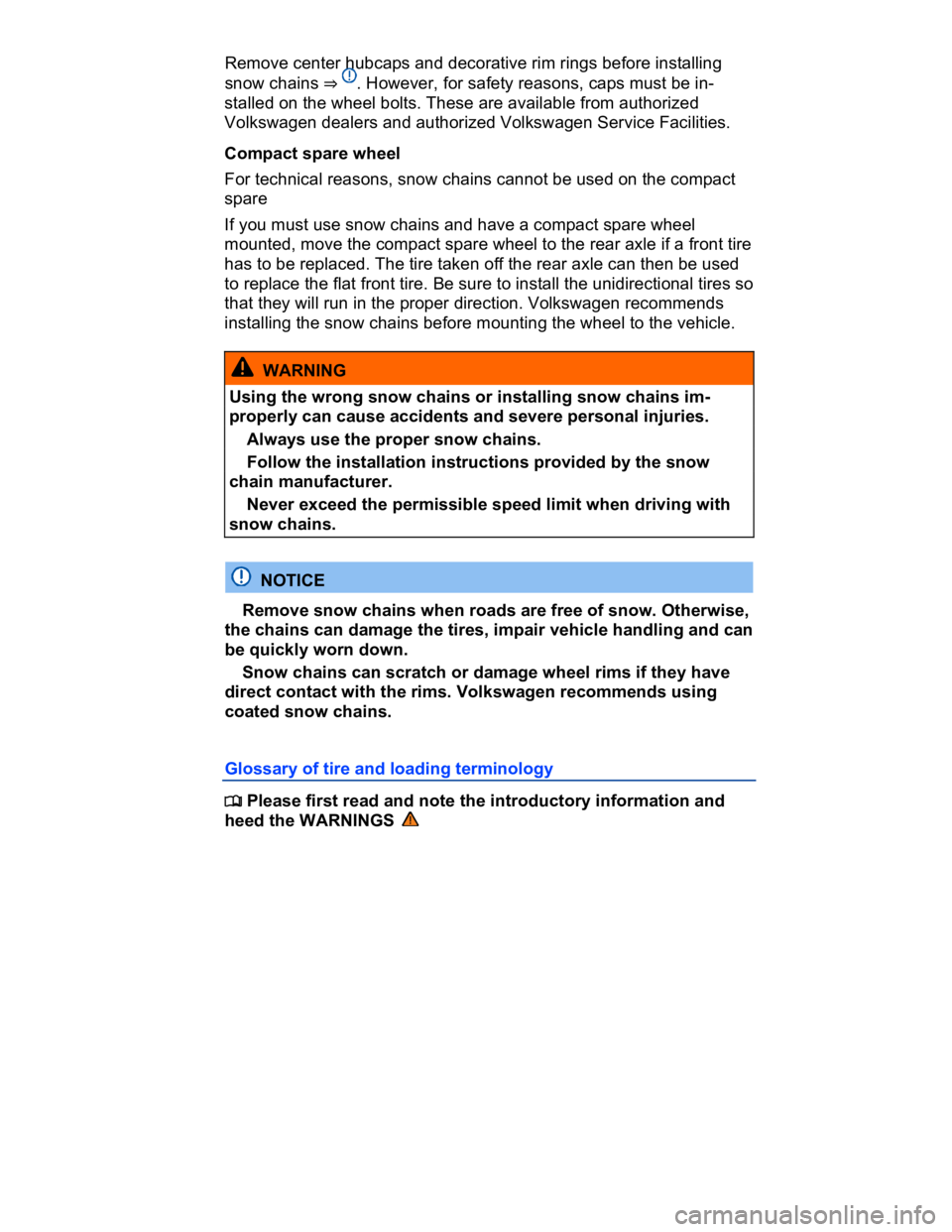2017 VOLKSWAGEN CC wheel
[x] Cancel search: wheelPage 255 of 578

Remove center hubcaps and decorative rim rings before installing
snow chains ⇒ . However, for safety reasons, caps must be in-
stalled on the wheel bolts. These are available from authorized
Volkswagen dealers and authorized Volkswagen Service Facilities.
Compact spare wheel
For technical reasons, snow chains cannot be used on the compact
spare
If you must use snow chains and have a compact spare wheel
mounted, move the compact spare wheel to the rear axle if a front tire
has to be replaced. The tire taken off the rear axle can then be used
to replace the flat front tire. Be sure to install the unidirectional tires so
that they will run in the proper direction. Volkswagen recommends
installing the snow chains before mounting the wheel to the vehicle.
WARNING
Using the wrong snow chains or installing snow chains im-
properly can cause accidents and severe personal injuries.
� Always use the proper snow chains.
� Follow the installation instructions provided by the snow
chain manufacturer.
� Never exceed the permissible speed limit when driving with
snow chains.
NOTICE
� Remove snow chains when roads are free of snow. Otherwise,
the chains can damage the tires, impair vehicle handling and can
be quickly worn down.
� Snow chains can scratch or damage wheel rims if they have
direct contact with the rims. Volkswagen recommends using
coated snow chains.
Glossary of tire and loading terminology
�
Page 256 of 578

Accessory weight
The combined weight (in excess of those standard items which may
be replaced) of automatic transmission, electro-mechanical power
steering, power brakes, power windows, power seats, radio, and
heater, to the extent that these items are available as factory-installed
equipment (whether installed or not).
Aspect ratio
The ratio of sidewall height to tire width, expressed as a percentage.
A number of 70 (0.7:1 or 70%) or lower indicates a low-profile tire with
a shorter sidewall for improved steering response and better overall
handling on dry pavement.
Bead
The part of a tire made of steel wires, wrapped or reinforced by ply
cords, with the shape and structure to ensure proper fit to the wheel
rim.
Bead separation
A breakdown of the bond between components in the bead.
Carcass
The tire structure, except tread and sidewall rubber which, when in-
flated, bears the load.
Chunking
The breaking away of pieces of the tread or sidewall.
Cord
The strands of material forming the plies in the tire.
Cord separation
The parting of cords from adjacent rubber compounds.
Cracking
Any parting within the tread, sidewall, or inner liner of the tire extend-
ing to cord material.
Cold tire inflation pressure
The tire pressure recommended by the vehicle manufacturer for a tire
of a specified size that has not been driven for more than a couple of
Page 258 of 578

Normal occupant weight
Means 150 lbs (68 kilograms) times the number of occupants seated
in the vehicle up to the total seating capacity of your vehicle.
Occupant distribution
The placement of passengers in a vehicle.
Outer diameter
The diameter of a new, properly inflated tire.
Overall width
Total width measured at the exterior sidewalls of an inflated tire, in-
cluding the additional width of labeling, decorations, or protective
bands or ribs.
Passenger car tire
A tire intended for use on passenger cars, multipurpose passenger
vehicles, and trucks, that have a gross vehicle weight rating (GVWR)
of 10,000 pounds or less.
Ply
A layer of rubber-coated parallel cords.
Ply separation
A parting of rubber compound between adjacent plies.
Pneumatic tire
A mechanical device made of rubber, chemicals, fabric, and steel or
other materials, that, when mounted on an automotive wheel, pro-
vides the traction and contains the gas or fluid that sustains the load.
Production options weight
The combined weight of installed regular production options weighing
over 5 lbs (2.3 kg) more than the standard items they replace, and not
previously considered as curb weight or accessory weight. These
include, for example, heavy-duty brakes, ride levelers, roof rack,
heavy-duty battery, and special trim.
Radial ply tires
A pneumatic tire in which the ply cords that extend to the beads are
laid at substantially 90 degrees to the centerline of the tread.
Page 259 of 578

Recommended inflation pressure
The tire pressure recommended by the vehicle manufacturer for a tire
of a specified size that has not been driven for more than a couple of
miles (kilometers) at low speeds in the 3 hour period before the tire
pressure is measured or adjusted.
Reinforced tire
A tire designed to operate at higher loads and at higher inflation pres-
sures than the corresponding standard tire.
Rim
The outer edge of a wheel upon which the tire beads are seated.
Rim diameter
The nominal diameter of the wheel's tire bead seating surface. If you
change your wheel size, to wheels of a different diameter, you will
have to purchase new tires to match the new wheels.
Rim size
Designation means rim diameter and width.
Rim type designation
The industry or manufacturer's designation for a rim by style or code.
Rim width
The nominal distance between wheel rim flanges.
Section width
The linear distance between the exteriors of the sidewalls of an inflat-
ed tire, excluding elevations due to labeling decoration, or protective
bands.
Sidewall
The portion of a tire between the bead and the tread.
Sidewall separation
The parting of the rubber compound from the cord material in the
sidewall.
Page 261 of 578

was manufactured. The last 4 numbers represent the week and year
of manufacture.
For example, the numbers 1709 mean that the tire was produced in
the 17th week of 2009. Any other numbers are marketing codes used
by the tire manufacturer. This information is used to help identify af-
fected consumers if a tire defect requires a recall.
Vehicle capacity weight
The total rated cargo, luggage and passenger load. Passenger load is
150 lbs (68 kilograms) times the vehicle's total seating capacity (as
listed on the label inside the driver door).
Vehicle maximum load on the tire
The load on an individual tire that is determined by taking each axle's
share of the maximum loaded vehicle weight (GAWR) and dividing
by 2.
Vehicle normal load on the tire
The load on an individual tire that is determined by taking each axle's
share of the curb weight, accessory weight, and normal occupant
weight (distributed according to the table below) and dividing by 2.
Wheel size designation
Wheel rim diameter and width.
Occupant loading and distribution for vehicle normal load for
various designated seating capacities
Designated seating
capacity, number of
occupants
Vehicle normal load,
number of occu-
pants
Occupant distribu-
tion in a normally
loaded vehicle
2, 3, or 4 2 2 in front
5 3 2 in front, 1 in back
Tires and vehicle load limits
�
Page 265 of 578

Treadwear
The treadwear grade is a comparative rating based on the wear rate
of the tire when tested under controlled conditions on a specified
government test course.
For example, a tire graded 150 (Treadwear-value 150) would wear
one-and-one-half (1 1/2) times as well on the government course as a
tire graded 100.
The relative performance of tires depends upon the actual conditions
of their use, however, and may depart significantly from the norm due
to variations in driving habits, service practices and differences in
road characteristics and climate.
Traction
The traction grades, from highest to lowest, are AA, A, B, and C.
Those grades represent the tire's ability to stop on wet pavement as
measured under controlled conditions on specified government test
surfaces of asphalt and concrete. A tire marked C may have poor
traction performance ⇒ .
Temperature
The temperature grades are A (the highest), B, and C representing
the tire's resistance to the generation of heat, and its ability to dissi-
pate heat when tested under controlled conditions on a specified in-
door laboratory test wheel.
Sustained high temperature can cause the material of the tire to de-
generate and reduce tire life, and excessive temperature can lead to
sudden tire failure.
The grade C corresponds to a level of performance which all passen-
ger car tires must meet under the Federal Motor Vehicle Safety
Standard No. 109. Grades B and A represent higher levels of perfor-
mance on the laboratory test wheel than the minimum required by law
⇒ .
WARNING
The traction grade assigned to this tire is based on straight-
ahead braking traction tests, and does not include acceleration,
cornering, hydroplaning or peak traction characteristics.
Page 268 of 578

WARNING
Incorrect tire pressures and/or underinflation can cause sudden
tire failure, loss of control, collision, serious personal injury or
even death.
� When the warning symbol appears in the instrument cluster,
stop and inspect the tires.
� Incorrect tire pressure and/or underinflation can cause in-
creased tire wear and can affect the handling of the vehicle and
stopping ability.
� Incorrect tire pressures and/or underinflation can also lead to
sudden tire failure, including a blowout and sudden deflation,
causing loss of vehicle control.
� The driver is responsible for the correct tire pressures for all
tires on the vehicle. The recommended tire pressure values are
listed on a sticker inside the driver door ⇒ Tire inflation pres-
sure.
� The TPMS can only work correctly when all tires on the vehi-
cle are filled to the correct cold tire inflation pressure specified
for the tires installed on the vehicle.
� Using incorrect tire pressure values can cause accidents or
other damage. Always inflate the tires to the correct specified
cold tire pressure values for the tires installed on the vehicle.
� Always maintain correct cold tire inflation pressure so that
TPMS can do its job.
� Always inflate tires to the recommended and correct tire
pressure before driving off.
� Driving with underinflated tires causes them to flex (bend)
more, letting them get too hot, resulting in tread separation,
sudden tire failure, and loss of control.
� Excessive speed and/overloading can cause heat build-up,
sudden tire failure, and loss of control.
� If the tire pressure is too low or too high, the tires will wear
prematurely and the vehicle will not handle well.
� If the tire is not “flat” and you do not have to change a wheel
immediately, drive carefully and at reduced speed to the near-
est service station to check the tire pressure and add air as re-
quired.
Page 269 of 578

� When replacing tires or wheel rims on vehicles equipped with
TPMS always read and heed the information and all WARNINGS
regarding tires and wheels ⇒ Tires and wheels.
NOTICE
� The wheel electronics are attached to special aluminum valves
on the wheels. These valves are screwed on rigidly. Never bend
the valves “into position” when checking and adjusting tire
pressure.
� Missing valve stem caps can cause damage to the valves as
well as to the TPMS sensors. To help prevent damage, always
use valve stem caps like those originally installed at the factory.
The caps must be screwed on tightly. Do not use metal valve
stem caps.
� Do not use “comfort valve caps.” They do not seal properly
and can damage the sensors.
� When replacing or rotating tires, make certain the valves and
sensors are not damaged.
� The aluminum valves that are installed should be replaced
after about 6 years of use because of aging in the rubber seals.
The valves can be replaced when a tire is changed. Do not reuse
aluminum valves after they are removed. They must be replaced.
The tire pressure sensor can be reused.
� When replacing the valve cores, use only nickel-plated re-
placement cores.
� The batteries in the wheel electronics last up to 10 years. It is
not possible to replace the batteries. The entire device must be
replaced.
Underinflation increases fuel consumption and tire wear.
Dispose of the wheel electronics and the old batteries in an envi-
ronmentally responsible manner. Batteries of the type used in the
wheel electronics may contain Perchlorate Material. Special handling
may apply. See www.dtsc.ca.gov/hadardouswaste/perchlorate. Obey
all applicable legal requirements regarding proper disposal.